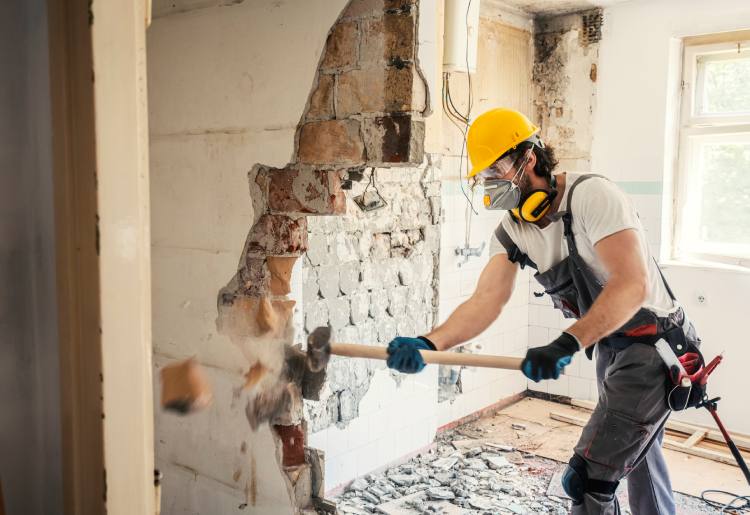Homeguard’s Ultimate Home Remodel Checklist

Considering a Home Remodel?
Remodeling your home can be a daunting task, but with proper planning and organization, it can be an exciting and rewarding experience.
To ensure that your home renovation goes smoothly, it’s important to create a comprehensive checklist.
Homeguard’s Ultimate Home Remodel Checklist will help you stay on track and achieve your dream home.
Set a Budget
Setting a budget is one of the most critical steps in any home renovation project. It helps you determine the scope of the project, the materials you can afford, and the timeline for completion. It’s important to set a realistic budget that takes into account all the expenses associated with the renovation.
The first step in setting a budget is to determine how much money you can afford to spend on the project. Consider your income, savings, and any financing options you may have. Be realistic about your financial situation and only commit to a budget that you can comfortably afford.
Next, consider all the expenses associated with the renovation. This includes materials, labor costs, permits, and any additional fees that may arise during the project.
Make a list of all the items you will need for the renovation, such as flooring, appliances, cabinets, and fixtures, and research the cost of each item. Get multiple quotes for labor costs and make sure to include permits and any other fees in your budget.
Once you have a comprehensive list of expenses, set a realistic budget that includes a contingency fund for unexpected expenses.
A contingency fund is essential in case of any unforeseen issues that may arise during the renovation, such as damage to the home or the discovery of mold or other problems. A general rule of thumb is to set aside 10-20% of your total budget for contingencies.
Keep in mind that going over budget is a common occurrence in home renovation projects. By setting a realistic budget and creating a contingency fund, you can reduce the risk of overspending and minimize the stress and financial burden of unexpected expenses.
Prioritize Your Needs
Prioritizing your needs is an essential step in any home renovation project. It helps you identify the areas of your home that need the most attention and ensures that your renovation project is focused and purposeful.
The first step in prioritizing your needs is to identify the areas of your home that need the most attention. This can include areas that are outdated, not functional, or in need of repair. For example, if your kitchen is outdated and not functional, prioritize a kitchen remodel. Or, if your bathroom is in need of repair, prioritize a bathroom remodel.
When deciding which areas of your home to prioritize, consider your lifestyle and your future plans. For example, if you love to cook and entertain, a kitchen renovation may be the most important project for you. If you plan on selling your home in the future, focus on renovations that will add the most value to your home, such as a bathroom or kitchen remodel.
Focus on the most crucial areas of your home to ensure that you get the most value out of your renovation. Prioritizing your needs can also help you stay within your budget by focusing on the most important areas first.
Make sure to also consider the long-term benefits of your renovation project. For example, a new roof or energy-efficient windows can help reduce your energy bills and increase the value of your home over time.
Determine Your Style
Determining your style helps you create a cohesive and harmonious look throughout your home and ensures that your renovation project reflects your personal taste. By determining your style, you can create a home that is both functional and beautiful.
The first step in determining your style is to browse through magazines and websites to get inspiration. Look for images that catch your eye and save them to create a visual reference for your renovation project.
You can create a mood board or Pinterest board to organize your ideas and help you visualize your design style.
When deciding on a design style, consider the overall aesthetic of your home and choose a style that complements it. For example, if your home has a modern aesthetic, a contemporary or minimalist design style may be the best fit. If your home has a more traditional aesthetic, a classic or vintage design style may be more appropriate.
When choosing a design style, consider the functionality of your space. Make sure that your design style is practical and functional for your lifestyle. For example, if you have children or pets, a minimalist design style may not be the best fit. Choose a style that is both beautiful and practical.
It’s also important to consider your budget when determining your style. Some design styles may be more expensive than others, so make sure to choose a style that fits within your budget.
You can use cost-effective design elements, such as paint and accessories, to create the look you want without breaking the bank.
Choose Quality Materials
Using high-quality materials can ensure that your renovation will last for many years, be durable and look great. By investing in high-quality materials, you can also save money in the long run by reducing the need for repairs and replacements.
One material that has become increasingly popular in recent years is a concrete overlay system for floors. This is a type of flooring that involves applying a layer of concrete over an existing surface, such as wood or tile. The result is a beautiful and durable surface that can be customized to fit any design style.
When choosing materials for your renovation project, it’s important to consider both durability and style. For example, if you have children or pets, it may be important to choose materials that are more resistant to wear and tear.
High-quality materials can be more expensive, but they are often worth the investment in the long run. However, you can still choose materials that fit within your budget without compromising on quality.
For example, you may be able to find high-quality materials at discounted prices or choose materials that are less expensive but still durable and stylish.
Another factor to consider when choosing materials is their environmental impact. If sustainability is important to you, look for materials that are eco-friendly and made from recycled or renewable materials.
Hire a Reputable Contractor
Hiring a reputable contractor is crucial for the success of your home renovation project. Your contractor will be responsible for managing the project, overseeing the work, and ensuring that the renovation is completed on time and within budget. It’s important to take the time to find the right contractor to ensure that your project runs smoothly and is completed to your satisfaction.
The first step in finding a reputable contractor is to look for someone who is licensed and insured.
A licensed contractor has met the necessary qualifications and has passed the required exams to operate in their specific field.
An insured contractor, on the other hand, provides you with protection against accidents and damages that may occur during the renovation process.
Once you have a list of potential contractors, research them thoroughly to ensure that they have a good reputation. One way to do this is to check online reviews from previous clients.
Read through the reviews carefully to get an idea of the contractor’s strengths and weaknesses. Pay attention to how the contractor responded to negative reviews and how they handled any issues that arose during the project.
Interview several contractors before making your final decision. Ask for references and make sure to follow up with them to get an idea of the contractor’s past performance. Discuss the details of your renovation project, including your budget, timeline, and specific requirements.
A good contractor will be able to provide you with a detailed estimate and explain the work that will be done.
When interviewing potential contractors, pay attention to their communication skills and responsiveness. A contractor who is easy to communicate with and responds promptly to your questions and concerns will make the renovation process much smoother.
Obtain Necessary Permits
Depending on the scope of the project, you may need permits from your local government to ensure that the work is up to code and safe for you and your family.
Not obtaining the necessary permits can lead to legal and financial issues down the line, so it’s important to take the time to obtain them before starting any work.
The permit process varies depending on where you live and the type of renovation you are planning. Generally, the process involves submitting an application to your local government and paying a fee.
The application will typically include details about the work you plan to do, such as the scope of the project, materials to be used, and any changes to the structure of the home. Once your application is approved, you will be issued a permit that authorizes the work to be done.
Note that if you start work without the necessary permits, you may face fines and legal issues. Your insurance may not cover any damages or injuries that occur as a result of the unpermitted work. This can be a costly mistake, so it’s important to take the time to obtain the necessary permits.
To determine whether you need permits for your renovation project, it’s best to check with your local government or building department. They can provide you with information on what permits you need and the application process.
It’s a good idea to work with a licensed contractor, as they will be familiar with the permit process and can help ensure that all necessary permits are obtained before work begins.
Set a Timeline
Creating a timeline helps to establish clear goals and deadlines for each phase of the renovation, from the planning stage to the final touches.
To create a timeline, start by breaking down your project into individual phases, such as demolition, framing, electrical work, plumbing, painting, and finishing touches.
For each phase, estimate how long it will take to complete and set a start and end date. Be realistic with your timeline and allow for unexpected delays, such as inclement weather or unexpected issues that may arise during the renovation.
It’s important to communicate your timeline with your contractor and any other professionals involved in the project. A clear and detailed timeline will help ensure that everyone is on the same page and that the project stays on track.
It’s a good idea to build in some flexibility to your timeline to allow for unexpected changes or delays. This can help reduce stress and allow for any necessary adjustments to be made without compromising the quality of the project.
Conclusion
Remodeling your home can be a rewarding experience with the proper planning and execution.
Homeguard’s Ultimate Home Remodel Checklist provides a roadmap for a successful home renovation.
By following this checklist, you can achieve your dream home and enjoy the benefits of a beautiful and functional living space.




